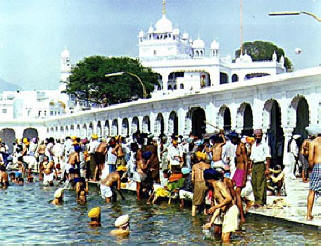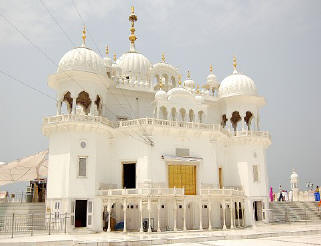Holy Destinations of India
Anandpur Sahib
 |
 |
|
Vicchora - Anandpur Sahib |
Anandpur Sahib Gurudwara |
A Picturesque Village, a 17th Century Fortress and an Impressive Gurudwara.
One of the holiest Sikh Shrines, Anandpur Sahib lies 75 km towards Dharamsala from Chandigarh. Apart from the famous gurudwara, this historical site also boasts of an imposing 17th century fortress.
North-west of Delhi, beyond the western edge of the Yamuna basin, lies the Land of the Five Rivers, universally known as the Punjab. Endowed with rich agricultural soil, plentiful irrigation and equable climatic conditions, the state is sometimes called the granary of India. Its villages, large and small, are key to the robust Punjabi attitude to life that has evolved through cross-cultural influences down the ages. The region is also home to the origin of the Sikh faith whose founder Guru Nanak preached here till his death 460 years ago in 1539. With neighboring Haryana, Punjab shares its capital at Chandigarh where excellent train, road and air services connect the 250 km distance to Delhi.
From Chandigarh, barely 75
km up the highway towards Dharamsala and Manali, lies Anandpur Sahib, the
impressive gurudwara that is one of the holiest Sikh shrines. Its
picturesque village, flanked by a 17th century fortress, is framed between
the Shivalik hills to the east and the Sutlej river farther away in the
west. Nature has been generous here. Much of the year, vast green expanses
will greet the visitor during the journey and also at the destination. Be
they the kharif (summer) crops of maize and paddy or the rabi (winter) wheat
emblazoned with mustard, there is a profusion of sylvan tranquility all
round.
Before the monsoon, the early sunrise will be followed by groups of men and
women setting out to ready their fields for the kharif sowing. With the
rainfall, the landscape transforms to extensive waterlogged patches where
the paddy must stand before it gets ready for the harvest.
The rabi season is different. Shawl flung across the shoulder, one’s farmer
friend will walk one through the bracing air to where the buffaloes are
tethered. Under the canopy of a peepul tree on the fringe of the ripening,
golden wheat, there is simply no gastronomic experience to match a thali of
sarson da saag with makke di roti topped off with a tall glass of fresh
lassi.
As one goes towards the interior, some of the elders will readily draw up a
cot to sit and barter information over a drink of sugarcane juice.
Interspersed with gentle Gurmukhi, the language of the Granth Sahib or holy
scripture of the faith, the conversation will veer round to the quality of
the crop, the prices of agricultural inputs and how modern technology has
been double-edged in its possibilities for multi-cropping but at escalating
cost!
One of the commonest means of transport is the ubiquitous tractor. As its
sputter punctures the calm of the village, one may join a colourfully
dressed group setting off to the market. And when it is harvest time,
virtually the entire village will lend a hand to cut and thresh the crop and
stack it up before it is despatched for sale to the nearest mandi.
Around this time, the festival of Baisakhi will witness renewed vigour. One
may join in the zesty bhangra as gaily-attired men and women charge the air
to a resounding drumbeat. Or on the day after Holi, join in the celebration
of Hola Mohalla for a re-enactment of the old battles that bore testimony to
Sikh valour. In the distance, the Sutlej flows on, having descended to the
plains near Anandpur Sahib through its timeless journey from Rakshas Tal at
the foot of Mount Kailash in Tibet.